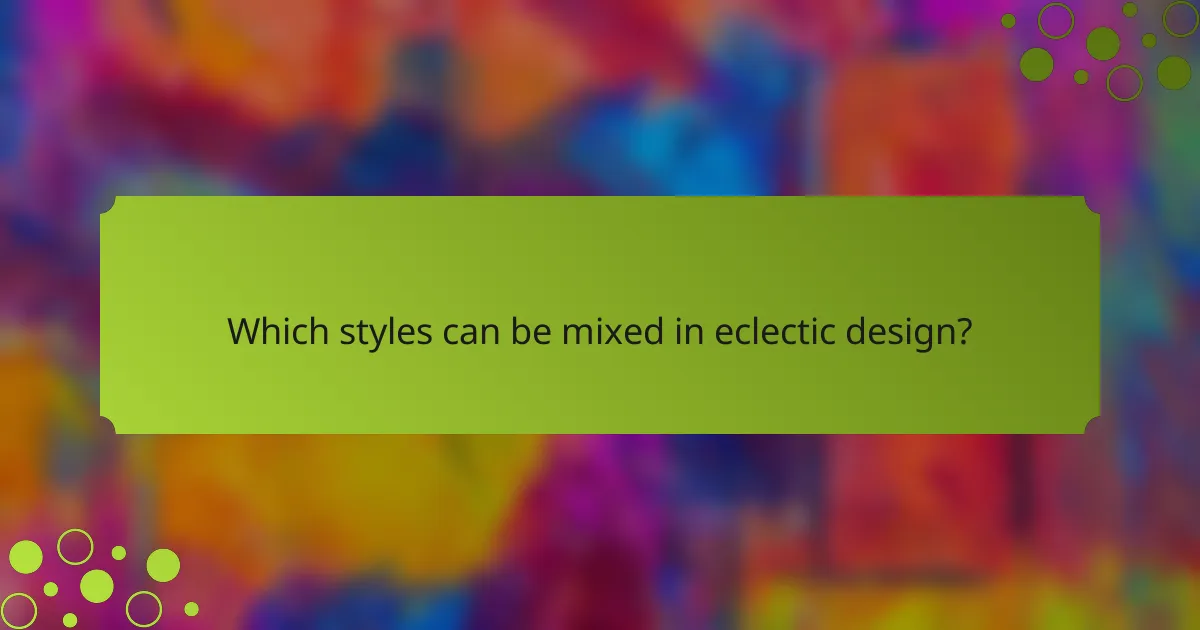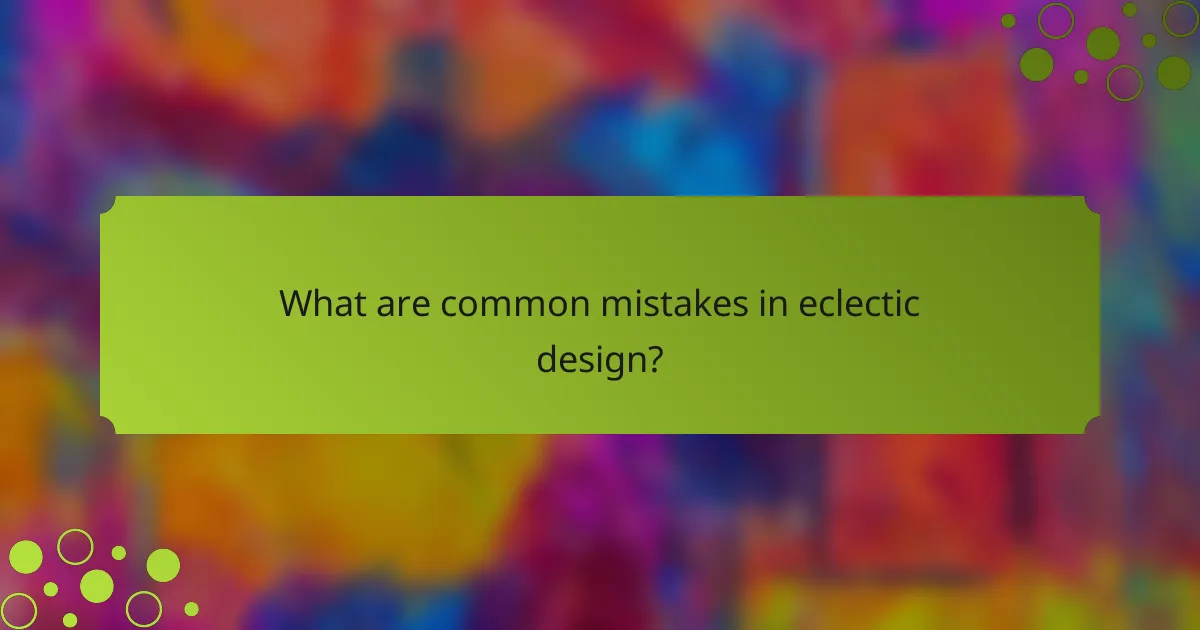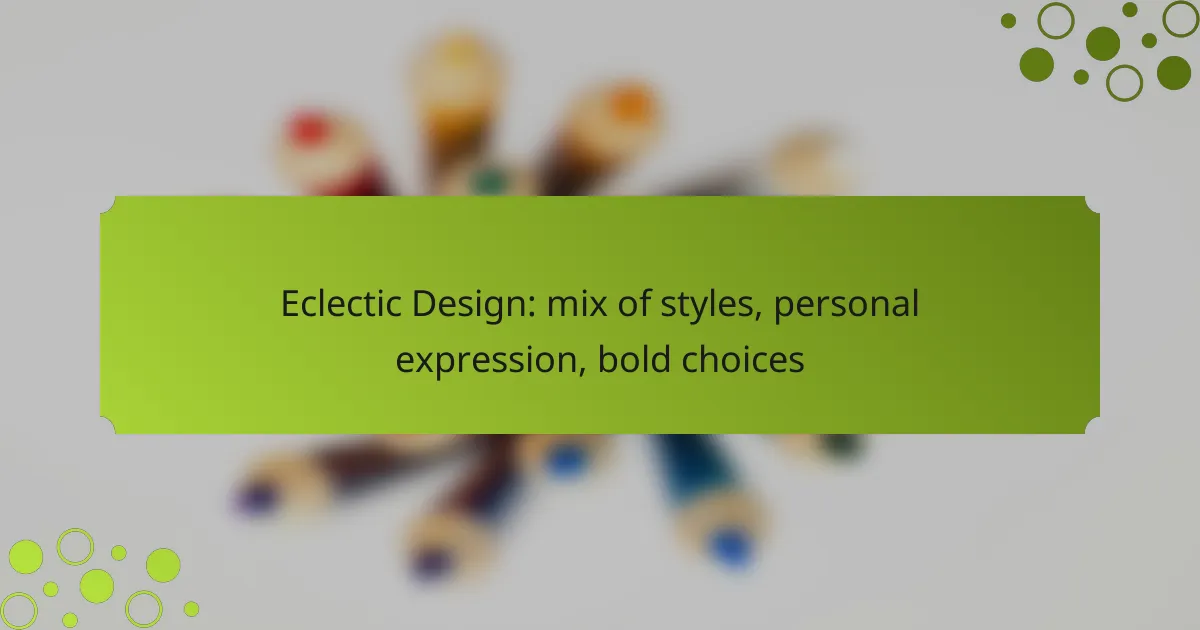Eclectic design is a vibrant approach that celebrates the fusion of diverse styles, colors, and textures, resulting in a uniquely personal aesthetic. By embracing bold choices and mixing various influences, individuals can create spaces that reflect their personality while maintaining a cohesive overall look. This style encourages creativity and allows for the harmonious integration of vintage and contemporary elements, making each space truly one-of-a-kind.

How to incorporate eclectic design in Australian homes?
Incorporating eclectic design in Australian homes involves blending various styles, colors, and textures to create a unique personal expression. Focus on mixing elements that resonate with your personality while ensuring a cohesive look throughout your space.
Mixing vintage and modern furniture
Combining vintage and modern furniture can create a striking contrast that enhances the eclectic aesthetic. Look for key pieces, such as a mid-century coffee table paired with contemporary chairs, to establish a focal point.
When selecting vintage items, consider their condition and style compatibility with modern pieces. Aim for a balance; for example, a rustic wooden sideboard can complement sleek, minimalist furniture effectively.
Using bold color palettes
Bold color palettes are essential in eclectic design, allowing for vibrant expression. Choose a few dominant colors and use them throughout the space to create harmony, while adding accent colors for visual interest.
Consider using colors that reflect the Australian landscape, such as earthy tones or bright coastal hues. A good rule of thumb is to use a 60-30-10 ratio: 60% dominant color, 30% secondary color, and 10% accent color for a balanced look.
Layering textures and patterns
Layering textures and patterns adds depth and character to eclectic interiors. Mix materials like wood, metal, textiles, and ceramics to create a rich sensory experience. For instance, a plush rug can soften a hard floor, while patterned cushions can enliven a neutral sofa.
When layering, aim for a cohesive theme by selecting patterns that share a common color or style. Avoid overwhelming the space; instead, focus on a few key textures and patterns that complement each other for a harmonious effect.

What are the key principles of eclectic design?
Eclectic design is characterized by the blending of various styles, materials, and influences to create a unique and personalized aesthetic. The key principles involve embracing diversity, making bold choices, and ensuring that the overall composition feels cohesive despite its varied elements.
Personal expression through unique choices
Personal expression is at the heart of eclectic design, allowing individuals to showcase their tastes and experiences through their decor. This can include mixing vintage and modern pieces, incorporating art from different cultures, or using colors that reflect one’s personality.
To effectively express individuality, consider selecting items that tell a story or hold sentimental value. For example, a family heirloom can be paired with contemporary furniture to create a striking visual contrast while maintaining personal significance.
Balancing contrasting styles
Balancing contrasting styles is crucial in eclectic design to ensure that the space feels harmonious rather than chaotic. This can be achieved by finding common threads, such as color palettes or materials, that link disparate elements together.
For instance, if you have a rustic wooden table, you might pair it with sleek metal chairs to create an interesting juxtaposition. Aim for a balance by limiting the number of different styles to three or four, which helps maintain visual coherence while still allowing for diversity.

Which styles can be mixed in eclectic design?
Eclectic design allows for a creative blend of various styles, encouraging personal expression through bold choices. Common combinations include mixing vintage pieces with contemporary elements, or pairing different cultural influences to create a unique aesthetic.
Mid-century modern with bohemian
Combining mid-century modern with bohemian styles creates a vibrant and inviting atmosphere. Mid-century modern furniture, characterized by clean lines and functional forms, can be paired with bohemian textiles and accessories that introduce color and texture.
To achieve this mix, select a few key mid-century pieces, such as a sleek sofa or a minimalist coffee table, then layer in bohemian elements like patterned rugs, woven wall hangings, and eclectic throw pillows. This contrast enhances visual interest while maintaining a cohesive look.
Industrial with rustic elements
Mixing industrial design with rustic elements results in a warm yet edgy space. Industrial features, such as exposed brick and metal fixtures, can be softened with rustic materials like reclaimed wood and vintage accents.
For a balanced approach, incorporate industrial lighting fixtures alongside rustic furniture, like a wooden dining table or a weathered sideboard. This combination not only highlights the strengths of each style but also creates a comfortable and inviting environment.

What are the benefits of eclectic design?
Eclectic design offers a unique blend of styles that allows for personal expression and bold choices, creating spaces that are both inviting and reflective of individual tastes. This approach encourages creativity and can lead to visually dynamic environments that stand out.
Reflects individual personality
Eclectic design is a powerful way to showcase personal identity through home decor. By mixing various styles, colors, and textures, individuals can create a space that feels authentically theirs. This style allows for the inclusion of cherished items, such as vintage finds or travel souvenirs, which can serve as conversation starters.
To effectively reflect your personality, consider incorporating elements that resonate with your experiences and interests. For instance, if you love art, displaying a mix of contemporary and traditional pieces can create a narrative that speaks to your journey.
Creates visually stimulating spaces
Eclectic design results in visually engaging environments that capture attention and spark interest. By combining different styles, such as modern with rustic or industrial with bohemian, you can create a layered look that invites exploration. This approach often leads to unexpected combinations that can delight the eye.
To achieve a balanced yet stimulating space, focus on a cohesive color palette or theme that ties the various elements together. For example, using a consistent color scheme across different furniture pieces can unify the space while still allowing for diverse styles. Avoid overcrowding the area; instead, select a few standout pieces that can serve as focal points.

How to choose color schemes for eclectic design?
Choosing color schemes for eclectic design involves selecting a mix of colors that reflect personal style while ensuring harmony. Focus on balancing bold and subtle hues to create a cohesive look that feels intentional rather than chaotic.
Complementary color combinations
Complementary color combinations involve pairing colors that are opposite each other on the color wheel, such as blue and orange or red and green. This approach creates vibrant contrasts that can energize a space. When using complementary colors, consider limiting the palette to two or three pairs to maintain visual balance.
For instance, a room with a predominantly blue theme can be accented with orange accessories like cushions or artwork. This not only adds interest but also emphasizes the eclectic nature of the design.
Accent colors for focal points
Accent colors serve to highlight focal points within an eclectic design, drawing attention to specific areas or features. Choose one or two bold accent colors that resonate with your overall color scheme, ensuring they stand out without overwhelming the space.
For example, if your primary colors are neutral tones, a vibrant yellow or deep teal can be used for a statement chair or a piece of art. This strategy enhances visual interest and reinforces the eclectic theme by creating a dynamic interplay of colors.

What are common mistakes in eclectic design?
Common mistakes in eclectic design include overcrowding with too many styles and lacking cohesive elements. These pitfalls can lead to a chaotic space that fails to express a clear personal aesthetic.
Overcrowding with too many styles
One of the main mistakes in eclectic design is using an excessive number of styles, which can overwhelm the space. A good rule of thumb is to limit the number of distinct styles to three or four, allowing for a more harmonious blend.
When combining styles, consider how each piece interacts with others. For instance, mixing modern furniture with vintage decor can work if there are common colors or materials that tie them together. Avoid the temptation to showcase every unique piece you own, as this can create visual clutter.
Lack of cohesive elements
A lack of cohesive elements can make an eclectic design feel disjointed. Cohesion can be achieved through color schemes, textures, or recurring motifs that create a sense of unity throughout the space.
For example, using a consistent color palette across different styles can help unify the overall look. Additionally, incorporating similar materials, such as wood or metal, can bridge the gap between various design elements. Always ask yourself how each item contributes to the overall theme to maintain a balanced aesthetic.

How to source eclectic decor in Australia?
Sourcing eclectic decor in Australia involves exploring unique items that reflect personal style and creativity. This can be achieved through various avenues, including local flea markets and vintage stores, which offer a diverse range of styles and materials.
Visiting local flea markets
Local flea markets are treasure troves for eclectic decor, featuring a mix of vintage, handmade, and unusual items. Markets like the Camberwell Market in Melbourne or the Glebe Markets in Sydney provide opportunities to discover one-of-a-kind pieces that can enhance your home’s character.
When visiting flea markets, arrive early for the best selection and be prepared to negotiate prices. Bring cash, as many vendors prefer it, and consider the size of your vehicle for transporting larger items. Keep an open mind and be willing to explore different styles.
Shopping at vintage stores
Vintage stores are excellent places to find eclectic decor that tells a story. Shops such as The Vintage Emporium in Brisbane or Vinnies in various locations offer a curated selection of furniture, art, and accessories from different eras.
While shopping at vintage stores, look for items that resonate with your personal aesthetic. Check for quality and condition, as some pieces may require minor repairs. Don’t hesitate to ask store staff for recommendations or insights about the history of specific items, which can add depth to your decor choices.
